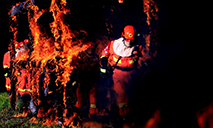NASA launches James Webb Space Telescope to see first galaxies, distant worlds
WASHINGTON, Dec. 25 (Xinhua) -- NASA's James Webb Space Telescope was launched from the Guiana Space Center in Kourou, French Guiana, on Saturday, in a revolutionary mission to seek the light from the first galaxies in the early universe and to explore the solar system, as well as planets orbiting other stars.
Launched onboard Arianespace's Ariane 5 rocket at 7:20 a.m. Eastern Standard Time (1220 GMT), Webb will travel to an orbit about 1.6 million km away from Earth and undergo six months of commissioning in space -- unfolding its mirrors, sunshield, and other smaller systems; cooling down; aligning; and calibrating, according to NASA.
Ground teams began receiving telemetry data from Webb about five minutes after launch. The Arianespace Ariane 5 rocket performed as expected, separating from the observatory 27 minutes into the flight.
Approximately 30 minutes after launch, Webb unfolded its solar array, and mission managers confirmed that the solar array was providing power to the observatory.
After solar array deployment, mission operators will establish a communications link with the observatory via the Malindi ground station in Kenya, and ground control at the Space Telescope Science Institute in Baltimore will send the first commands to the spacecraft.
Engineers and ground controllers will conduct the first of three mid-course correction burns about 12 hours and 30 minutes after launch, firing Webb's thrusters to maneuver the spacecraft on an optimal trajectory toward its destination in orbit about 1 million miles from Earth, according to NASA.
Webb is NASA's largest and most powerful space science telescope ever constructed. With a 6.5-meter primary mirror, the large infrared telescope will study every phase of cosmic history -- from within the solar system to the most distant observable galaxies in the early universe, said NASA.
Webb will directly observe a part of space and time never seen before. It will gaze into the epoch when the very first stars and galaxies formed over 13.5 billion years ago, according to NASA.
The space telescope will also be a powerful tool for studying the nearby universe, said NASA. Scientists will use Webb to study planets and other bodies in the solar system to determine their origin and evolution and compare them with exoplanets, planets that orbit other stars.
"The James Webb Space Telescope represents the ambition that NASA and our partners maintain to propel us forward into the future," said NASA Administrator Bill Nelson.
"The promise of Webb is not what we know we will discover; it's what we don't yet understand or can't yet fathom about our universe," he said.
"Now we will watch Webb's highly anticipated and critical 29 days on the edge. When the spacecraft unfurls in space, Webb will undergo the most difficult and complex deployment sequence ever attempted in space. Once commissioning is complete, we will see awe-inspiring images that will capture our imagination," said Gregory L. Robinson, Webb's program director at NASA headquarters.
Webb is an international program led by NASA with the European Space Agency and the Canadian Space Agency.
Photos
Related Stories
- Retired NASA astronaut praises Chinese female astronaut Wang Yaping
- NASA launches longest mission to distant asteroids, exploring planet formation mysteries
- SpaceX cargo Dragon docks to space station
- NASA scientist congratulates China on its first Mars landing
- NASA's SpaceX first crew mission on way home from space station
Copyright © 2021 People's Daily Online. All Rights Reserved.










